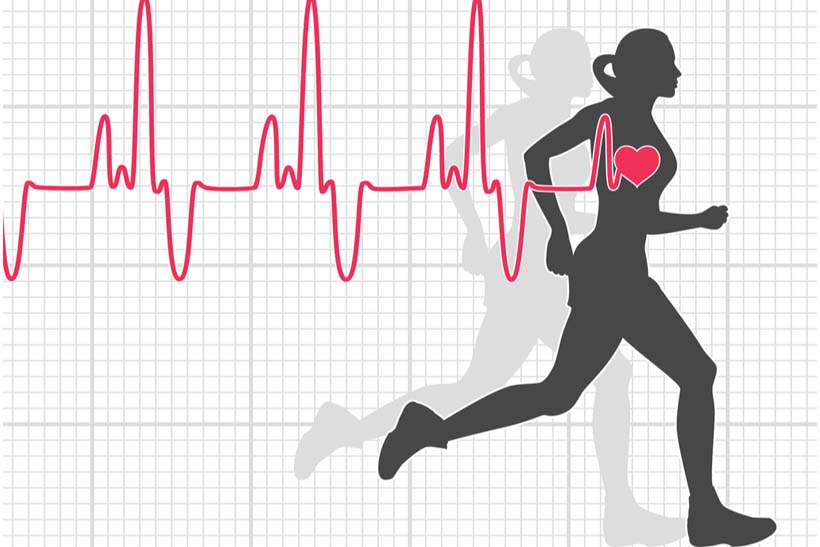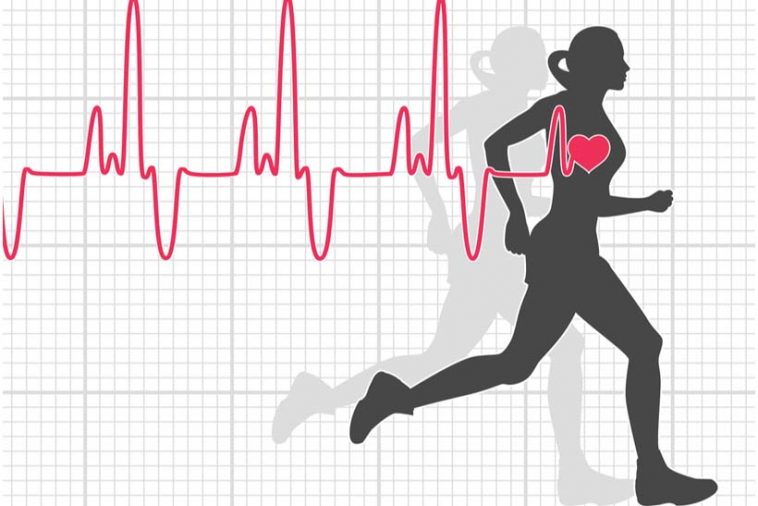- Like
- SHARE
- Digg
- Del
- Tumblr
- VKontakte
- Flattr
- Buffer
- Love This
- Save
- Odnoklassniki
- Meneame
- Blogger
- Amazon
- Yahoo Mail
- Gmail
- AOL
- Newsvine
- HackerNews
- Evernote
- MySpace
- Mail.ru
- Viadeo
- Line
- Comments
- Yummly
- SMS
- Viber
- Telegram
- JOIN
- Skype
- Facebook Messenger
- Kakao
- LiveJournal
- Yammer
- Edgar
- Fintel
- Mix
- Instapaper
- Copy Link
Introduction
 To attain health and fitness, exercise is a must, and exercising 30 minutes with a 120 beats per minute heart rate puts your body in a “fat-burning zone,” in which you can burn 150 calories.
To attain health and fitness, exercise is a must, and exercising 30 minutes with a 120 beats per minute heart rate puts your body in a “fat-burning zone,” in which you can burn 150 calories.
Consequently, you can burn 300 calories by spending 30 minutes exercising with a 170 beats target heart rate.
Understanding how your heart rate is affected is important when you’re exercising because it helps determines if you’re burning your desired amount of fats as well as dictates the current status of your overall health.
In this post, you’ll learn the important benefits of understanding your heart rate, as a crucial aspect during exercise. In this way, you can make the best fitness decisions for yourself to attain overall health and fitness.
Understanding Your Heart Rate Provides Health Basis
Your target heart rate reflects how fast the heart should be beating during exercise. Measuring your heart rate is important to attain your fitness goals and good health. But of course, you should take your target heart rate. It’s one way you can use the heart rate result as a basis during exercise.
Here’s how you can take your target heart rate:
- Get Your Resting Heart Rate: To determine your resting heart rate, find your pulse, which can be palpated inside your wrist, right on the thumb side. Don’t use your thumb to get your pulse, instead use your first two fingers, pressing the tips lightly over the artery.
- Normal Heart Rate: Count the number of pulse or beats in one full minute. Take note that the result is your resting heart rate. The average heart rate when a person is at rest or not exercising is between 60 and 100 beats per minute. For very fit people, their heart rate is between 40 to 50 beats per minute because the more fit a person is, the lower is the resting heart rate.
- Calculate Target Heart Rate: The target heart rate is also called “fat-burning heart rate “because it’s the ideal heart rate in which the body starts to burn fat. To get your target heart rate, it ‘s generally between 50 and 85 percent of the maximum safe heart rate, depending on your age and subtracted from 220. For instance, if you’re 40 years old and your maximum heart rate is 200, you subtract 40 to get a result of 160 beats per minute. So if your target heart rate is 50 percent at exertion level, your target should be 80 beats per minute. With a level of exertion of 85 percent, the target is 136 beats per minute. It means that the target heart rate of a 40-year old is 80 to 136 beats per minute.
Note: You can easily find out your target heart rate skipping the math by wearing a fitness tracking device, or exercising on a treadmill to automatically calculate your target heart rate.
Understanding and Monitoring Heart Rate Helps You Develop an Effective Exercise Plan
There are many factors that affect the heart, aside from exercise. Your heart rate may change during exercise, along with other internal and external factors. By knowing these factors, you’ll be able to create an effective exercise plan to attain your fitness goals.
Here are some important factors that can affect your heart rate and should be considered when developing an effective exercise plan:
- Body Size: While body size generally doesn’t change heart rate, overweight individuals might observe a higher resting pulse rate than normal, not over 100 beats per minute.
- Body Position: Your body position affects your heart rate. When you’re sitting, standing, or resting, your pulse is usually the same. However, your pulse rate may go up a little bit once you get up and stand for 15 to 20 seconds. It’s considered normal, and your pulse rate should be back to normal after a couple of minutes.
- Emotions: Your emotions can also raise your heart rate, like when you’re excited, stressed, or feel threatened.
- Air Temperature: When the humidity or temperatures soar, the normal action of the heart is to pump more blood, so your heart rate may increase, but no more than 5 to 10 beats per minute.
- Medications: Medications that can block your adrenaline like beta-blockers may slow your pulse rate. On the other hand, excessive thyroid medication will raise your heart rate.
Understanding and Monitoring Heart Rate Gives Your Directed Motivation
According to Michael Blaha, M.D., M.P.H., a cardiologist at For Johns Hopkins, By understanding your target heart rate, you’ll be more motivated to achieve it. Most of his workouts take place in his home. His elliptical trainer has built-in electrodes, and he can place his hands onto it to automatically monitor his heart rate.
Blaha said that knowing his heart rate gives him a sense of how hard he’s working. He uses his targeted heart rate as a course guide he programmed into the elliptical trainer. In this way, he can exercise according to his preference in terms of exertion. Understanding your heart rate enables you to gain health and fitness benefits, which are truly rewarding.
Understanding and Monitoring Heart Rate Helps You Create Safe and Effective Exercises
Your exercise goals and fitness level influence the intensity of workout appropriate for you to ensure safety and effectiveness. Heart rate is a great indicator of the body’s physiological adaptation during exercise. It depicts your body’s capability to sustain the intensity of effort. That’s why heart rate monitoring is a vital component in training programs and cardiovascular fitness assessment.
One way to monitor your heart rate during exercise is by using wearable devices like smartwatches or mobile heart rate. They are used to measure the heart rate accurately and help in safe and effective exercise.
Here’s a quick guide on safe target heart rate zone according to age:
- 20 years old: 100-170 bpm average heart rate and 200 bpm maximum heart rate
- 30 years old: 95-162 bpm average heart rate and 190 bpm maximum heart rate
- 35 years old: 93-157 bpm average heart rate and 185 bpm maximum heart rate
- 40 years old: 90-153 bpm average heart rate and 180 bpm maximum heart rate
- 45 years old: 88-149 bpm average heart rate and 175 bpm maximum heart rate
- 50 years old: 85-145 bpm average heart rate and 170 bpm maximum heart rate
- 55 years old: 83-140 bpm average heart rate and 165 bpm maximum heart rate
- 60 years old: 80-136 bpm average heart rate and 160 bpm maximum heart rate
- 65 years old: 78-132 bpm average heart rate and 155 bpm maximum heart rate
- 70 years old: 75-128 bpm average heart rate and 150 bpm maximum heart rate
*Target HR Zone at 50 to 85%
*Average Maximum Heart Rate at 100%
Understanding and Monitoring Heart Rate Helps You Meet Your Fitness Goals
Monitoring and trying to achieve your target heart rate during exercise can help you meet your fitness goals. More so, if your goals include weight loss and improving cardiovascular health. Your target heart rate creates a zone in which your body burns fat and best benefit from aerobic exercise.
Before you perform a cardiovascular exercise, it’s important to establish your target heart rate to help attain your fitness goals. You’ll be more committed to attaining and sustaining your target heart rate, say with 20 to 25 minutes performing cardiovascular exercise, which gains better results as compared to a person who spends an hour doing random exercises. It’s one way to keep your heart rate elevated for a more effective workout.
Here are some tips when monitoring your heart rate during exercise to achieve your fitness goals:
- Make sure that you monitor your heart rate every 5-minute increments during a cardio workout. It would determine if you’re exercising hard enough and if you’re over-exerting yourself.
- Monitor your heart rate in any form of training or workout you do to help increase your cardio capacity and decrease your weight.
- You can use any heart rate monitoring device such as activity tracker watches, chest straps, or cardiovascular machines with a heart rate gauge.
- If you’re planning to engage in circuit-style strength training or cross-fit, you should know your maximum heart rate when you’re exerting yourself.
Understanding and Monitoring Heart Rate Helps You Burn More Fat
One of the major goals of why people exercise is to lose weight. However, many people think that sweating during a cardio exercise means shedding more fats or calories, which is not really the case.
If you want to accelerate your fat-burning regimen, you’ve got to develop a workout plan that targets your average target heart rate. Aside from monitoring your heart rate, you should also know the different types of exercises that can increase the likelihood of burning more fats.
Here are the types of exercise that can help you burn fat:
- Running
- Bicycling
- Jump lunges
- Box jumps
- Dumbbell jacks
- Kettlebell swing
- Dumbbell squat
- Crunch squat
Note: A good combination of aerobic and resistance and strengthening exercises can help you attain your weight loss and fitness goals.
Conclusion
There are plenty of important benefits, monitoring, and understanding your heart rate while exercising. Your heart rate, specifically, your target heart rate, is a great basis in developing the best workout plan without compromising your safety and general health. It gives you peace of mind that you’re exercising without stressing your heart too much, most especially if you have cardiovascular problems or related history.
About Shannon Clark
Shannon holds a degree in Exercise Science and is a certified personal trainer and fitness writer with over 10 years of industry experience.

